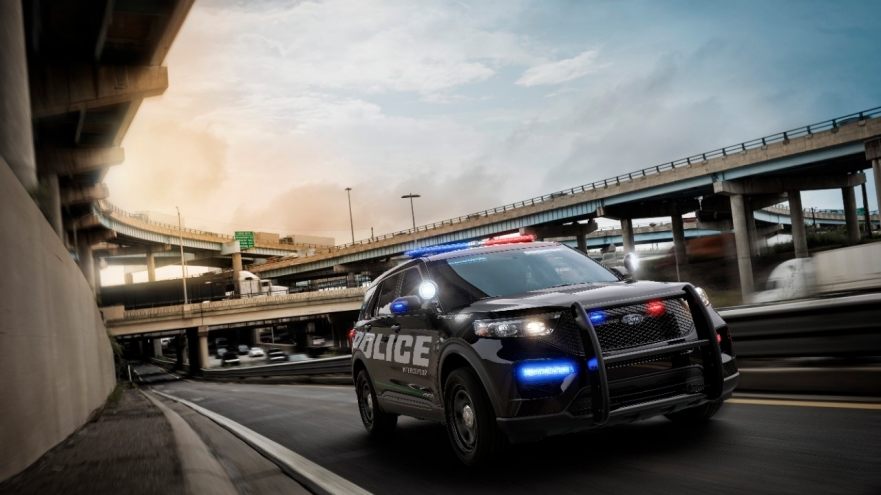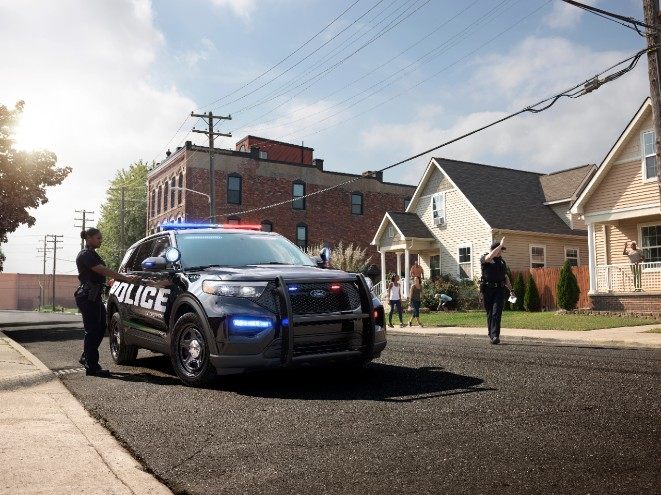
The all-new Ford 2020
A hybrid vehicle is ideal for our law enforcement, and not to mention taxpayers – because of the potential for significant idle-time fuel and cost savings. When police vehicles are stationary, a conventional gasoline engine must run continuously to power emergency lighting, radios, computers
“Our Police Interceptor Utility’s standard hybrid powertrain provides the potential for significant fuel savings with improved performance and no tradeoffs in safety or interior passenger or cargo space,” said Stephen Tyler, Ford police brand marketing manager. “It’s a win-win-win formula for law enforcement.”
The new and improved 2020 Police Interceptor Utility hybrid has a projected EPA-estimated rating of 24 MPG combined, a 41 percent improvement over the current Police Interceptor Utility equipped with a 3.7-liter gas engine. Projections indicate the first pursuit-rated hybrid police utility will save between $3,500 and $5,700 per vehicle annually in fuel costs versus the current Police Interceptor Utility*. If those savings were applied to every Police Interceptor Utility sold in 2017, it would equate to between $118 million and $193 million*, or more than 43 million gallons of fuel.
In recent testing by Michigan State Police, the all-new Police Interceptor Utility hybrid had the fastest 0-100 mph acceleration, fastest lap, fastest average lap and highest top speed of 137 mph, versus competitive police utility vehicles tested, including V8-powered entries. The only faster entry was its cousin – Ford Police Interceptor Utility powered by a 3.0-liter EcoBoost®engine.
At the Los Angeles County Sheriff’s Department testing, the new Police Interceptor Utility hybrid bested the outgoing 3.7-liter model in 0-60 mph by 1.1 seconds and 0-100 mph by 4.7 seconds. It also turned a faster lap time that was 2.4 seconds better than the 3.7-liter and fastest average lap time that was 1.7 seconds better.
Technology that Keeps Officers S

The Police Interceptor Utility is equipped with a number of advanced features designed to officer safety. Factory-installed Police Perimeter Alert uses sensors to monitor an approximately 270-degree area around the vehicle. It analyzes nearby movement to detect potentially threatening behavior. When such motion is detected, the system automatically turns on the rear camera, sounds a chime, rolls up the windows and locks the doors. Motion trails of the detected threat appear on the digital instrument cluster so officers can monitor.
Available driver-assist technology includes Pre-Collision Assist with automatic emergency braking, which features Pedestrian Detection and forward collision warning. A unique disable switch for law enforcement allows officers to temporarily override the system to perform precision immobilization technique maneuvers when necessary.
Additional optional equipment includes Rear Camera On-Demand, which allows officers to view behind the vehicle at the touch of a button, and a host of factory-installed and factory-sealed wiring and lighting packages that offer agencies turnkey solutions.
Three powertrain options for the all-new Police Interceptor Utility include a standard 3.3-liter hybrid, plus available 3.0-liter EcoBoost® and 3.3-liter V6 engines. All are powered by a new 10-speed automatic transmission and feature standard full-time Intelligent All-Wheel Drive and deep snow/sand traction control mode.
“Whether patrolling or sitting idle, the all-new Police Interceptor Utility will change the way officers work,” said Bill Gubing, chief engineer for Police Interceptor Utility and Ford Explorer. “Everything about it was designed for keeping police officers safe, comfortable and ready for action.”
A proud History of Outfitting Law Enforcement

The popularity of Ford police vehicles continues a history that spans nearly seven decades. In that time, Ford has outfitted law enforcement with purpose-built vehicles based on some of its most popular nameplates.
In 1950, Ford became the first manufacturer to offer a police package vehicle, focusing then – as it does now – on safety, durability, performance and the attributes of being purpose-built and upfit-friendly. The Interceptor name debuted on the optional 110-horsepower flathead V8 engine for 1951.
By 1961, 58 percent of police vehicles in use in the 50 largest U.S. cities were Ford models. An emphasis on delivering total performance – including driving dynamics such as acceleration, braking and cornering – continued throughout the 1960s.
The Crown Victoria name was given to the Police Interceptor in 1983. Its available police package featuring an optional 351-cubic-inch 5.8-liter high-output V8 helped make it the preferred choice of municipalities across North America for decades.
Ford discontinued the once-ubiquitous V8-equipped Crown Victoria in 2011, and since then, its new Police Interceptors – most notably, Police Interceptor Utility – have continued to refortify law enforcement fleets. In 2017, Ford Police Interceptor Utility alone accounted for more than half of all police vehicle sales in the United States, outselling all other police vehicles combined.
EPA Estimated MPG. See FuelEconomy.gov for details. *Computed using fuel costs of $2.75 to $4.50 per gallon.
The Reed Factor is proud to support our law enforcement and grateful for their service! You can also stay up-to-date on all the latest automotive news via The Reed Factor Facebook and Twitter social channels!

